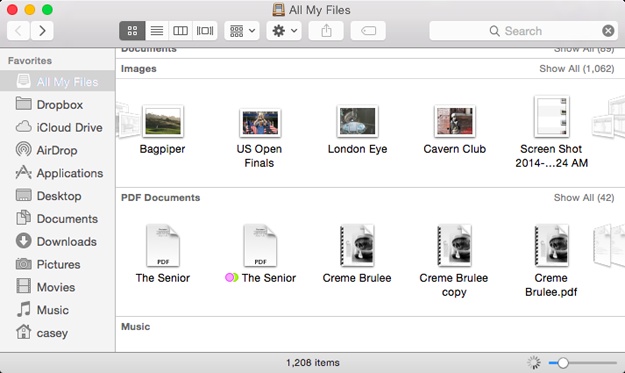If you open the icon for your main hard drive (Macintosh HD) from the Go→Computer window, for example, all you’ll find in the Macintosh HD window is a set of folders called Applications, Library, and Users.
Most of these folders aren’t very useful to you, the Mac’s human companion. They’re there for OS X’s own use. Think of your main hard drive window as storage for the operating system itself, which you’ll access only for occasional administrative purposes.
In fact, the folders you really do care about boil down to these:
When it comes to managing your programs, the Applications folder (which you can open by choosing Go→Applications) is something like the Program Files folder in Windows—but without the worry. You should feel free to open this folder and double-click things. In fact, that’s exactly what you’re supposed to do. This is your complete list of programs. (What’s on your Dock is more like a Greatest Hits subset.)
Better yet, on the Mac, programs bear their real, plain-English names, like Microsoft Word, rather than abbreviations, like WINWORD.EXE. Most are self-contained in a single icon, too (rather than being composed of hundreds of little support files), which makes copying or deleting them extremely easy.
Your documents, files, and preferences, meanwhile, sit in an important folder called your Home folder. Inside are folders that closely resemble the Documents, Pictures, and Music folders on Windows.
OS X is rife with shortcuts for opening this all-important folder:
Choose Go→Home.
Press Shift-⌘-H.
Click the
 icon in the Sidebar (The Finder Sidebar). (If you don’t see it there, then choose Finder→Preferences→Sidebar and turn on the
icon in the Sidebar (The Finder Sidebar). (If you don’t see it there, then choose Finder→Preferences→Sidebar and turn on the  checkbox in the list of Places.)
checkbox in the list of Places.)
Within your Home folder, you’ll find another set of standard folders. (You can tell the Mac considers them holy because they have special logos on their folder icons.) Except as noted, you’re free to rename or delete them; OS X creates the following folders solely as a convenience:
Desktop. When you drag an icon out of a folder or disk window and onto your OS X desktop, it may appear to show up on the desktop. But that’s just a visual convenience. In truth, nothing in OS X is really on the desktop. It’s actually in this Desktop folder, and mirrored in the desktop area.
Documents. Apple suggests that you keep your actual work files in this folder. Sure enough, whenever you save a new document (when you’re working in Keynote or Word, for example), the Save As box proposes storing the new file in this folder.
Your programs may also create folders of their own here. For example, you may find a Microsoft User Data folder for your Outlook email, a Windows folder for use with Parallels or VMware Fusion (Chapter 8), and so on.
Library. The main Library folder (the one in your main hard drive window) contains folders for your Mac’s system-wide fonts, preferences, help files, and so on.
You have your own Library folder, too. It stores the same kinds of things—but they’re your fonts, your preferences, and so on. It’s generally hidden, although you can get to it by pressing Option as you choose Go→Library.
Movies, Music, Pictures. These folders, of course, are designed to store multimedia files. The various OS X programs that deal with movies, music, and pictures will propose these specialized folders as storage locations. For example, when you plug a digital camera into a Mac, the iPhoto program automatically begins to download the photos on it—and stores them in the Pictures folder. Similarly, iMovie is programmed to look for the Movies folder when saving its files, and iTunes stores its MP3 files in the Music folder.
Public. If you’re on a network, or if others use the same Mac, this folder can be handy: It’s the “Any of you guys can look at these files” folder. Other people on your network, as well as other people who sit down at this machine, are allowed to see whatever you’ve put in here, even if they don’t have your password. (If your Mac isn’t on an office network and isn’t shared, then you can throw this folder away.) More details on sharing and networking on the Mac are in Chapter 16.
Forcing you to keep all your stuff in a single folder has some major advantages. Most notably, by keeping such tight control over which files go where, OS X keeps itself pure—and very, very stable.
This folder is the same idea as the Windows or WINNT folder on a PC, in that it contains hundreds of files that are critical to the functioning of the operating system. These files are so important that moving or renaming them could render the computer useless, as it would in Windows. For maximum safety and stability, you should ignore OS X’s System folder just as thoroughly as you ignored the old Windows folder.
Get Switching to the Mac: The Missing Manual, El Capitan Edition now with the O’Reilly learning platform.
O’Reilly members experience books, live events, courses curated by job role, and more from O’Reilly and nearly 200 top publishers.


